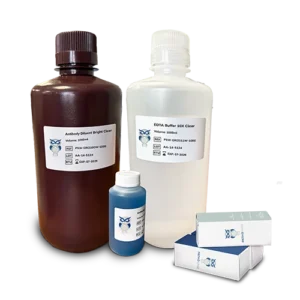In IHC protocols, buffers and reagents such as EDTA, Tris-EDTA, Citrate, Diluent, and PBS (Phosphate Buffered Saline) play crucial roles at various stages. EDTA is often used for antigen retrieval by chelating calcium ions to reverse the cross-links formed during formalin fixation, exposing epitopes for antibody binding. Tris-EDTA, with a balanced pH environment of around 9.0, aids in breaking these cross-links without damaging tissue morphology, making it a preferred choice for both washing and antigen retrieval. Citrate buffer, usually at a pH of 6.0, is extensively used in heat-induced epitope retrieval (HIER) for unmasking a wide range of antigens.
Diluents are essential for diluting primary and secondary antibodies, ensuring optimal antibody binding while minimizing background staining-common options include PBS, Tris buffer, and commercial solutions like Antibody Diluent. Lastly, PBS is a ubiquitous buffer used throughout the process for washing sections, diluting antibodies, and as a base for other solutions, maintaining stable pH and osmolarity to preserve tissue integrity and antigenicity. Choosing the appropriate buffers ensures the best possible staining results, leading to accurate and reliable diagnostic interpretations.
